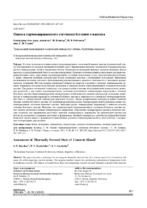Оценка термонапряженного состояния бетонного массива

Date
2021Publisher
Another Title
Assessment of Thermally Stressed State of Concrete Massif
Bibliographic entry
Ковшар, С. Н. Оценка термонапряженного состояния бетонного массива = Assessment of Thermally Stressed State of Concrete Massif / Ковшар, П. В. Рябчиков, С. В. Гущин // Наука и техника. – 2021. – № 3. – С. 207-215.
Abstract
В статье изложена методика оценки термонапряженного состояния бетонного массива фундаментной плиты, изготовленной из самоуплотняющейся бетонной смеси. Предлагаемая методика заключается в предварительном расчете температурных полей в твердеющем бетоне. Объектами исследований являлись самоуплотняющаяся бетонная смесь и конструкционный бетон в массиве конструкции. Приведен и обоснован выбор материалов для приготовления бетонной смеси. Для оценки термонапряженного состояния использован состав самоуплотняющегося бетона. С целью снижения величины саморазогрева бетона применяли вяжущее с пониженной экзотермией. Выполнены исследования по оценке удельного тепловыделения рекомендованного цемента в зависимости от начального водоцементного отношения. Изучено влияние химической добавки на скорость и величину удельного тепловыделения цемента. Приведены основные теоретические положения и алгоритм расчета термонапряженного состояния бетонного массива. Для расчета ожидаемых температур и их распределения в массиве конструкции использовали метод конечных разностей, а для оценки термонапряженного состояния рассчитывали температурные напряжения в сечениях бетонного массива. Выполненные расчеты температурных полей позволили оценить максимально возможные температуры и температурные перепады по сечениям бетонного массива в зависимости от начальной температуры бетонной смеси и среднесуточной температуры наружного воздуха. Анализ распределения температур выявил наиболее опасные сечения бетонного массива. На основании результатов расчета температурных полей проведена оценка термонапряженного состояния бетонного массива. Выполнен расчет температурных напряжений в наиболее опасных сечениях бетонного массива. Показано, что характеристикой термонапряженного состояния бетонного массива может служить расчетная величина температурного напряжения. Образование температурных трещин в бетонном массиве возможно при превышении расчетного значения температурного напряжения над фактической прочностью бетона на растяжение. Сравнение расчетных и фактических значений температур в сечениях фундаментной плиты позволило сделать вывод о правильности выполненных расчетов температурных полей и, как следствие, о возможных температурных деформациях.
Abstract in another language
The paper describes a technique for assessing the thermally stressed state of a concrete massif of a foundation slab made of a self-compacting concrete mixture. The proposed method consists in a preliminary calculation of temperature fields in hardening concrete. The objects of research have been self-compacting concrete mix and structural concrete in the structure mass. The choice of materials for the preparation of a concrete mixture is given and substantiated. The composition of self-compacting concrete has been used to assess the thermally stressed state. A binder with a reduced exotherm has been used in order to reduce the self-heating of concrete. Studies have been carried out to assess the specific heat release of the recom- mended cement depending on the initial water-cement ratio. The effect of a chemical additive on the rate and magnitude of the specific heat release of cement has been studied. The paper presents the main theoretical provisions and an algorithm for calculating the thermal stress state of a concrete massif. The finite difference method has been used to calculate the expected temperatures and their distribution in the structure mass, and the temperature stresses in the sections of the concrete mass have been calculated to assess the thermally stressed state. The performed calculations of the temperature fields have made it possible to estimate the maximum possible temperatures and temperature differences over the sections of the conc- rete massif depending on the initial temperature of the concrete mixture and the average daily temperature of the outside air. Analysis of the temperature distribution has revealed the most dangerous sections of the concrete mass. An assessment of the thermal stress state of the concrete mass has been made on the basis of the results pertaining to calculation of temperature fields. The calculation of temperature stresses in the most dangerous sections of the concrete massif has been performed. It is shown that the calculated value of the temperature stress can serve as a characteristic of the thermally stressed state of the concrete mass. The formation of temperature cracks in a concrete mass is possible when the calculated value of the tempera-ture stress exceeds the actual tensile strength of concrete. Comparison of the calculated and actual values of temperatures in the sections of the foundation slab has made it possible to conclude that the calculations of the temperature fields and, as a consequence, possible temperature deformations are correct.
View/
Collections
- № 3[10]
